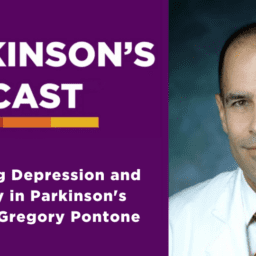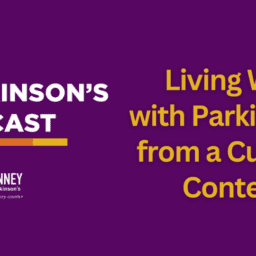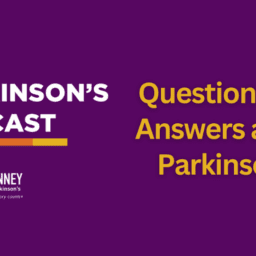 What is Parkinson’s? The basics: Parkinson’s is a complex neurological disorder that can affect almost every part of the body, ranging from how you move to how you feel to how you think and process. While researchers have discovered certain genetic and environmental factors that seem to influence the development of Parkinson’s, there is no single cause of Parkinson’s or predictor of who will get it. Parkinson’s is not life-threatening, but it is progressive, meaning symptoms and effects of Parkinson’s get worse over time.
What is Parkinson’s? The basics: Parkinson’s is a complex neurological disorder that can affect almost every part of the body, ranging from how you move to how you feel to how you think and process. While researchers have discovered certain genetic and environmental factors that seem to influence the development of Parkinson’s, there is no single cause of Parkinson’s or predictor of who will get it. Parkinson’s is not life-threatening, but it is progressive, meaning symptoms and effects of Parkinson’s get worse over time.
Since Parkinson’s affects everyone differently, the specific ways you choose to live well will be unique and will change over time. However, a positive attitude, staying engaged in your own health, consistently exercising and making a commitment to take action are steps everyone living with Parkinson’s can take to live well right now.
In this article, we help you learn more about Parkinson’s and gain a better understanding so you can make informed decisions and improve your quality of life.
Parkinson’s is a brain disorder associated with a loss of dopamine-producing nerve cells (neurons) deep inside the brain. Dopamine is a neurotransmitter (a chemical substance) that helps regulate the body’s movement. Less dopamine in the brain means less control over movement and less mobility in general. Many treatments for Parkinson’s work to replace or enhance lost dopamine.
Parkinson’s is both chronic and progressive, which means symptoms will change and get worse as time goes on. The rate of progression will vary from person to person. While Parkinson’s does not directly cause death, complications such as choking due to swallowing difficulties, pneumonia from aspirating food into the lungs or severe injury caused by falls that can come in the late stages of Parkinson’s may lead to death.
Parkinson’s is officially classified as a movement disorder because it involves damage to the areas of the brain, nerves and muscles that affect the speed, quality, fluency and ease of movement. While the effects of Parkinson’s on movement are often the most visible symptoms, like tremor, other impacts of Parkinson’s not related to movement, like emotional and cognitive challenges, can sometimes have an even greater effect on your quality of life.
No two people living with Parkinson’s will experience symptoms or progression of it in the exact same way. Just because something is listed as a symptom of Parkinson’s doesn’t mean you will experience it.
Often, non-motor symptoms of Parkinson’s begin before the more visible physical symptoms. These are called “pre-motor symptoms.” Symptoms such as loss of smell, depression and constipation may appear years before your actual diagnosis.
Other non-motor symptoms of Parkinson’s can include difficulties sleeping, trouble with executive functioning, like making a decision or packing a suitcase, mood changes that can bring depression, apathy, anxiety (or some combination of these), sleep problems and fatigue.
The more visible physical symptoms of Parkinson’s, like tremors, slowness or stiffness, start in most people after 60-80% of certain dopamine-producing nerve cells are damaged. These symptoms are called motor symptoms. One of the main jobs dopamine-producing nerve cells have is controlling our movement, which includes the planning and initiation of movement. As these dopamine-producing neurons are lost, once routine everyday activities like walking and balance are affected.
How Does Parkinson’s Change Over Time?
Because Parkinson’s is a chronic condition, your symptoms and available treatment options will change over time. Everyone’s experience with Parkinson’s is different, which can make anticipating the progression of symptoms frustrating.
To best understand what to expect from symptoms, read our Every Victory Counts® manual for living well.
The important thing is to make a commitment to start. Stop waiting and start moving. Your goal isn’t simply to accept Parkinson’s. Your goal is to live well. –Davis Phinney
While there are common symptoms, Parkinson’s affects everyone differently. Simply because something is considered a symptom of Parkinson’s does not mean you will necessarily experience it.
In the same way, being informed about the various effects Parkinson’s can have will help you and your family take action to live well today. Keep in mind that the combination of different Parkinson’s symptoms can sometimes compound the effects of each symptom, making you feel more overwhelmed and frustrated. For instance, falling asleep and staying asleep can be challenging for people with Parkinson’s. And not getting a good night’s rest makes you more tired during the day, which can exacerbate feelings of fatigue and mood shifts like anxiety, apathy and depression.
Common symptoms of Parkinson’s include:
- Pre-motor: symptoms that happen before the common movement symptoms appear
- Motor: symptoms that primarily impact movement
- Non-motor: symptoms not directly related to movement, such as changes in mood, skin, vision, swallowing and how your brain processes information
Pre-Motor Symptoms of Parkinson’s
Diagnosing Parkinson’s typically focuses on the presence of cardinal motor signs of slowness, stiffness and rest tremor. However, many people with Parkinson’s can look back and realize they started experiencing early non-motor symptoms many years before motor symptoms began.
Early non-motor symptoms have become known as pre-motor symptoms, which include:
- Rapid eye movement sleep behavior disorder (RBD): may start 15 – 50 years before motor symptoms. The temporary “paralysis” most of us experience when we sleep preventing us from acting out our dreams is disrupted in people with RBD, so they physically act out their dreams.
- Constipation: may start 10 – 20 years before motor symptoms
- Depression and anxiety: may start up to 20 years before motor symptoms
- Loss of smell: may occur only a short time before motor symptoms appear
Researchers are investigating pre-motor symptoms with the hope that more information could help doctors diagnose Parkinson’s earlier, before so many of the dopamine-producing nerve cells are lost and motor symptoms set in. More knowledge about how Parkinson’s develops and evolves may also enable researchers to determine how to slow the progression of Parkinson’s or even prevent motor symptoms from starting.
Motor Symptoms
The impacts of Parkinson’s on movement are called motor symptoms. Primary motor symptoms include:
- Tremor: a rhythmic shaking in your arms, legs or chin. Most people with Parkinson’s who experience tremor that is worse when relaxing and resting have rest tremor. Others experience active tremor, which means their shaking will worsen when trying to do something, like drinking out of a cup of coffee or eating with a spoon.
- Rigidity: painful stiffness, often in the arms, legs, neck or back muscles.
- Akinesia, Bradykinesia, Hypokinesia: Akinesia and bradykinesia refer to the reduction of movement, slowness of movement and sometimes even complete lack of movement that can be caused by Parkinson’s. Hypokinesia refers to a loss of momentum or force in movement that can come with Parkinson’s, usually in connection with akinesia, bradykinesia or both. The small, cramped handwriting (called micrographia) that some people with Parkinson’s experience is thought to be some combination of akinesia and hypokinesia.
- Postural Instability: balance problems caused by a loss of reflexes that help you stay upright. This can cause challenges with general balance as well as walking (especially making a turn). Sometimes postural instability brings the tendency to fall backward, called retropulsion.
Early motor symptoms can also include a mask-like face or loss of facial expression, small, cramped handwriting (micrographia) and decreased natural arm swing.
People often complain of a heaviness feeling, dragging of one side or cramping in certain muscles. Speech can become softer and more difficult as Parkinson’s progresses and swallowing can also be affected.
As Parkinson’s progresses, walking can change from shuffling steps to festination, or a tendency toward smaller and faster steps that can tip you forward. Sometimes people with Parkinson’s will experience freezing of gait, feeling like your feet are glued to the floor and trouble starting to walk again once this happens. Freezing often occurs when you first begin to walk, make a turn or are in a tight and crowded space.
Other movement symptoms of Parkinson’s include:
- Reduced manual dexterity, making everyday tasks like buttoning a shirt difficult
- Severe muscle cramping
- Pain without obvious cause
Learn more about motor symptoms and how to take action to live well today.
Non-Movement (Non-Motor) Symptoms
Parkinson’s is officially classified as a movement disorder and many of the most visible symptoms of Parkinson’s affect movement. Although these motor symptoms are often more noticeable, Parkinson’s also causes effects that are not related to movement, called non-motor symptoms. Non-motor symptoms may actually outnumber motor symptoms and can appear years before motor symptoms.
Non-motor symptoms can include:
- Cognitive challenges
- Memory problems
- Feeling tongue-tied
- Fatigue
- Sleep problems
- Anxiety
- Depression
- Apathy
- Loss of smell
- Numbness or tingling
- Pain
Some of the non-motor symptoms of Parkinson’s are connected to the effects Parkinson’s has on the autonomic nervous system, which controls functions your body “automatically” does, like blood pressure, sweating, digestion and heart rate.
Non-motor symptoms of Parkinson’s that can be caused by changes and impairment to the autonomic nervous system include:
- Constipation
- Frequent need to urinate that can develop into incontinence
- Lightheadedness, especially when getting up in the morning or rising from a chair or couch
- Sexual dysfunction, especially erectile dysfunction
- Excess salivation (drooling)
- Excessive perspiration
Learn more about non-motor symptoms and how to take action to live well today.
Parkinson’s is second only to Alzheimer’s as the most common neurodegenerative disease in the United States, affecting between 1 million to 1.5 million Americans. There are more people living with Parkinson’s in the U.S. than the number of people living with multiple sclerosis, muscular dystrophy and Lou Gehrig’s disease (ALS) combined.
An estimated 50,000 to 60,000 new cases of Parkinson’s are reported annually in the U.S. alone. Between 7 and 10 million people are estimated to be living with Parkinson’s around the world.
Most people living with Parkinson’s are older than 65 and about 60 percent are male. About 1 in 100 people over the age of 60 have Parkinson’s, while there are fewer than 1 in 1,000 people under the age of 50 living with Parkinson’s. 15% of people with Parkinson’s are under age 50 and only 5% are under age 40. Typically, individuals under the age of 50 and diagnosed with Parkinson’s are referred to as having young onset Parkinson’s (YOPD).
There is no known cause of Parkinson’s, nor have scientists identified a set of characteristics that accurately predict if someone will develop Parkinson’s. Discovering a biomarker, a biological characteristic that can predict if someone will develop a certain condition, is a current focus of ongoing research.
What Causes Parkinson’s?
While researchers have discovered certain genetic and environmental factors that seem to influence the development of Parkinson’s, there is no single cause of Parkinson’s or predictor of who will get it.
The complexity of the brain has made the search for the underlying causes of Parkinson’s difficult. While there is currently no known cause of Parkinson’s, scientists and researchers believe a unique combination of genetics, environment, lifestyle and other factors are at play for each person who develops it. Some people with Parkinson’s may have a genetic connection and will often have someone else in their family with Parkinson’s. Others may point to specific environmental factors, such exposure to pesticides, or lifestyle factors, like head trauma, that they believe influenced their developing Parkinson’s.
If you are uniquely interested in helping researchers better understand what causes Parkinson’s, visit clinicaltrials.gov and foxtrialfinder.org.
Since no two cases of Parkinson’s are ever exactly alike, Parkinson’s can be very difficult to diagnose. Physicians determine you have Parkinson’s after reviewing your medical history, self-reported symptoms and a clinical examination conducted by a neurologist or a movement disorder specialist.
A Parkinson’s diagnosis requires you have two out of three primary motor symptoms:
- Tremor (shaking, usually of the arm, leg or chin, while at rest)
- Rigidity (stiffness)
- Bradykinesia (slow movement)
To support the diagnosis, your healthcare provider will also look for other symptoms:
- Micrographia (small handwriting)
- Reduced facial expression (mask-like face)
- Decreased arm swing or leg drag on one side of the body while walking
Symptoms such as shoulder pain, depression, sleep problems, constipation and loss of sense of smell can begin long before any of the motor symptoms appear. Because symptoms like these can be subtle at first, they are not always evident or meaningful before diagnosis. It is common after being diagnosed with Parkinson’s to look back and realize symptoms had been coming on gradually for months or even years. Often people explore other treatment avenues for early symptoms, like physical therapy or even surgery for pain, only to discover later it was actually connected to Parkinson’s.
Since doctors diagnose other medical conditions using sophisticated technology, many are surprised to learn a Parkinson’s diagnosis is based on your medical history and a simple examination. While your healthcare provider may take other steps, such as order blood and urine tests, check copper levels and order a brain scan, such as an MRI or CT or DaTscan that measures dopamine, these tests do not diagnose Parkinson’s. They are used to either confirm the diagnosis or determine if another medical condition is causing your symptoms.
Most people associate Parkinson’s with the elderly. Although the risk of Parkinson’s does increase as we age, Parkinson’s affects people of all ages. The definition varies from source to source, but most refer to a diagnosis of Parkinson’s before the age of 50 as young onset Parkinson’s disease or YOPD. Estimates vary, but between 4% and 10% of people living with Parkinson’s were diagnosed as young onset.
Everyone’s experience of Parkinson’s will be unique, and a person with YOPD may have similar symptoms as someone diagnosed later in life.
There are some key differences between young onset and idiopathic (or typical) Parkinson’s:
- In general, individuals diagnosed with YOPD may experience a slower progression of Parkinson’s.
- Dystonia, an involuntary and sometimes painful contraction of your muscles that leads to twisting, pulling or bending across a joint is more common in those with YOPD and may be one of the first symptoms experienced. Dystonia can appear as toe curling, the foot turning in (called foot inversion) or arm or hand flexion or cramping. Sadly, these symptoms in younger individuals can lead to misdiagnosed orthopedic issues (and unnecessary surgery) before they get to a diagnosis of Parkinson’s.
- There appears to be a lower rate of cognitive impairment in younger individuals with Parkinson’s, including dementia.
- Motor symptoms of both young and older-onset Parkinson’s respond well to medication. Over time though, complications from the medication can become a problem, which lead to ups and downs in your response to Parkinson’s medications throughout the day. Both motor fluctuations (ups and downs in the effectiveness of the medication) and dyskinesia (involuntary movements caused by the medication) can occur earlier in the progression of Parkinson’s and tend to be more severe in YOPD.
YOPD presents a unique experience of Parkinson’s. Not only will you live with Parkinson’s longer, but your stage of life is also very different from those diagnosed later, such as in their sixties and seventies. Individuals who are diagnosed at a younger age are often fully engaged in careers, parenting younger children and providing care for their own parents. This often means you may have less time to invest in your own self-care, a critical piece of living well with Parkinson’s.
Women with YOPD are often still menstruating and describe the impact Parkinson’s symptoms, as well as Parkinson’s medications, have on their menstrual cycles and the management of those cycles.
People with young onset Parkinson’s are also faced with difficult decisions about their ability to work as well as what the future will look like much sooner than they thought. Many individuals report they find themselves forced to retire earlier than planned, which leads to financial worries and uncertainty.
What you can do right now to live well
If you’re living with young onset Parkinson’s:
- Find a physician who understands the unique issues presenting in treating a younger person with Parkinson’s.
- Create a robust care team that can change and evolve with you as your experience of Parkinson’s changes and evolves.
- Learn what self-care you require and give yourself permission to engage it.
- Exercise, exercise, exercise! Develop and commit to a sustained and varied exercise plan.
- Pay attention to what you are eating. Be sure you are getting the important nutrients your body needs and are mindful of which foods make the impacts of Parkinson’s worse.
- Reduce stress. Stress worsens all aspects of Parkinson’s.
- Planning for the future. Have honest conversations with your spouse and family and consider working with a long-term planning professional.
Learn more through the APDA National Young Onset Center.
Research and personal experiences of people living with Parkinson’s continue to show incredible impacts through simple lifestyle changes including stress reduction, getting enough sleep, a healthy diet and exercise. Follow the links below to learn more about these simple changes and get started on your path to living well.
Every Victory Counts® manual for living well with Parkinson’s
Abridged Parkinson's Glossary
















